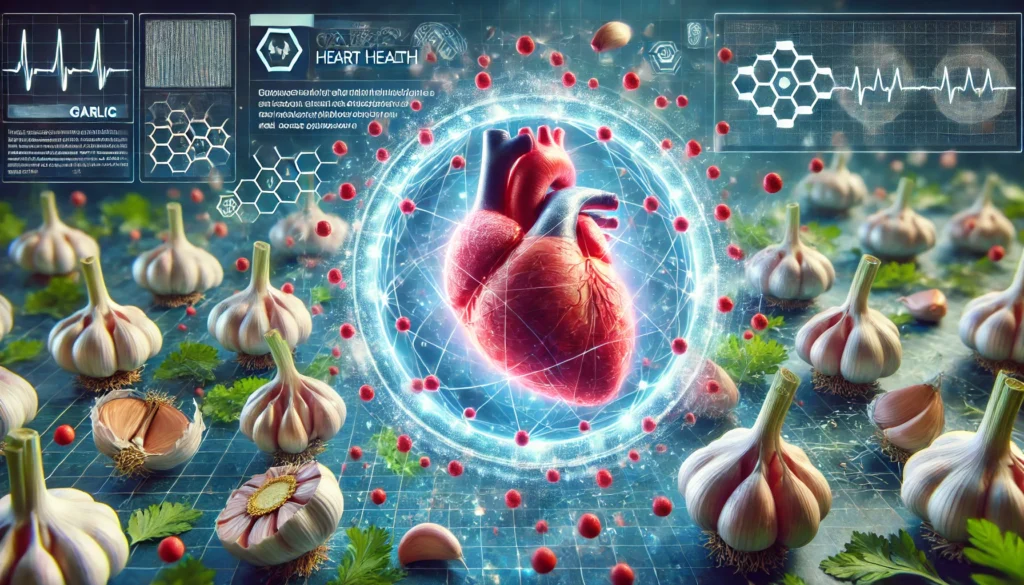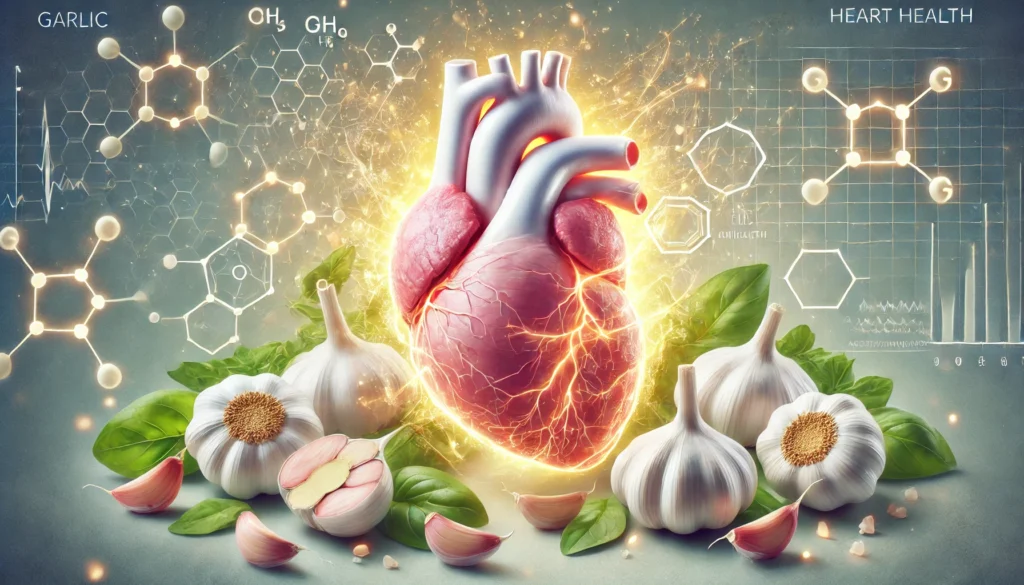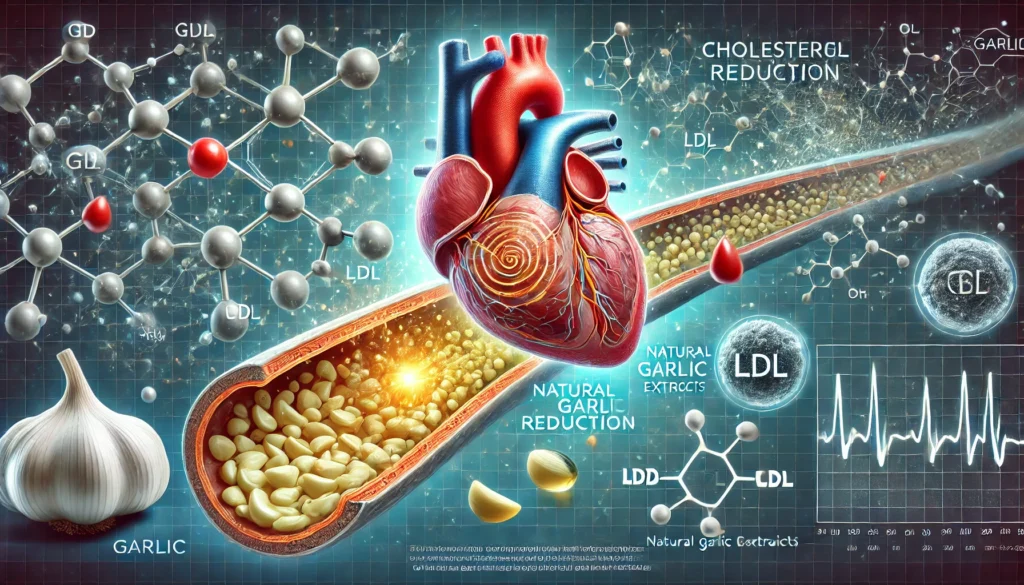Introduction: The Role of Garlic in Cardiovascular Health
Garlic has been revered for centuries for its medicinal properties, often cited as a natural remedy for various ailments, particularly those related to heart health. Among the most widely discussed benefits of garlic is its potential ability to influence cholesterol levels. But does garlic lower cholesterol? Can it effectively reduce LDL, often referred to as “bad” cholesterol? And how does it fit within the broader context of cardiovascular health? This article will explore the scientific evidence behind garlic’s role in cholesterol management, detailing its mechanisms, potential benefits, and limitations while maintaining a critical approach rooted in medical expertise and trustworthiness.
You may also like: Best Herbs for Heart Health: Natural Remedies to Support Cardiovascular Wellness

Understanding Cholesterol and Its Impact on Health
Cholesterol is a lipid molecule essential for various bodily functions, including cell membrane integrity, hormone production, and bile synthesis. However, an imbalance in cholesterol levels, particularly an elevation in low-density lipoprotein (LDL) cholesterol, has been linked to an increased risk of cardiovascular diseases. LDL cholesterol can contribute to plaque formation in arteries, leading to atherosclerosis, heart attacks, and strokes. Conversely, high-density lipoprotein (HDL) cholesterol is considered protective, as it helps transport excess cholesterol to the liver for excretion. Managing cholesterol levels is, therefore, a crucial aspect of maintaining cardiovascular health.
Garlic and Its Bioactive Compounds
Garlic (Allium sativum) contains numerous bioactive compounds, the most significant being allicin. This sulfur-containing compound is released when garlic is crushed or chopped and is believed to be responsible for many of its health benefits. Allicin exhibits antioxidant, anti-inflammatory, and lipid-lowering properties. Other compounds in garlic, such as S-allyl cysteine, diallyl disulfide, and ajoene, also contribute to its therapeutic effects. These compounds interact with various biological pathways that influence lipid metabolism, oxidative stress, and vascular function.
Mechanisms by Which Garlic May Reduce Cholesterol
Scientific studies have explored multiple pathways through which garlic exerts its lipid-lowering effects. One proposed mechanism is its ability to inhibit hepatic cholesterol synthesis. Similar to statins, garlic appears to interfere with the enzyme HMG-CoA reductase, which plays a crucial role in cholesterol production. Additionally, garlic has been shown to enhance bile acid secretion, promoting cholesterol excretion from the body. Another mechanism involves garlic’s antioxidant properties, which help reduce the oxidative modification of LDL cholesterol—a key factor in atherosclerosis progression. By mitigating oxidative stress and inflammation, garlic may contribute to a more favorable lipid profile.

Evaluating the Scientific Evidence
Numerous clinical studies have investigated whether garlic helps with cholesterol management. A meta-analysis of randomized controlled trials found that garlic supplementation significantly reduced total cholesterol and LDL cholesterol while increasing HDL cholesterol in some cases. However, the extent of these effects varied depending on factors such as dosage, preparation method, and duration of supplementation. A study published in the Journal of Nutrition reported that aged garlic extract reduced LDL cholesterol by approximately 10%, a modest but potentially meaningful reduction for individuals seeking natural approaches to cardiovascular health.
Despite these findings, other studies have yielded mixed results. Some trials have shown minimal or no significant changes in cholesterol levels with garlic supplementation. The variability in outcomes may stem from differences in study design, participant characteristics, and garlic formulations. Raw garlic, aged garlic extract, and garlic oil all contain different concentrations of bioactive compounds, influencing their effectiveness.
Comparing Garlic to Conventional Cholesterol-Lowering Treatments
While garlic shows promise in cholesterol management, it is important to compare its efficacy to established pharmacological treatments. Statins, the most commonly prescribed cholesterol-lowering drugs, have been extensively studied and are known to reduce LDL cholesterol by 30% to 50%. In contrast, garlic’s effects are typically more modest, often ranging from 5% to 15% reductions in LDL cholesterol. This discrepancy underscores the need for individuals with high cardiovascular risk to consult healthcare professionals before relying solely on garlic for cholesterol management.
Potential Side Effects and Considerations
Garlic is generally well tolerated, but it is not without side effects. Common adverse effects include gastrointestinal discomfort, bloating, and a strong odor in breath and sweat. In some individuals, garlic may cause allergic reactions or exacerbate acid reflux. More importantly, garlic possesses antiplatelet properties, meaning it can thin the blood and potentially interact with anticoagulant medications like warfarin. Individuals on blood-thinning medications should exercise caution and seek medical advice before incorporating high doses of garlic into their routine.
Practical Applications: How to Use Garlic for Cholesterol Management
For those interested in using garlic for cholesterol reduction, several practical considerations should be taken into account. Fresh garlic, aged garlic extract, and garlic supplements each offer different concentrations of bioactive compounds. Raw garlic is the most potent but can be challenging to consume in large quantities due to its strong taste and odor. Aged garlic extract, available in capsule or liquid form, provides a more palatable alternative while retaining many of the beneficial compounds. Studies suggest that a daily intake of 600 to 1,200 mg of aged garlic extract may yield cholesterol-lowering effects. Including garlic in a heart-healthy diet alongside other cholesterol-lowering foods, such as fiber-rich vegetables, nuts, and fatty fish, can further enhance its benefits.

Frequently Asked Questions (FAQ) on Garlic and Cholesterol
1. How does garlic interact with cholesterol metabolism in the body?
Garlic contains bioactive compounds, particularly allicin, that have been shown to influence cholesterol metabolism through multiple pathways. One of the primary ways in which garlic helps with cholesterol management is by inhibiting the activity of HMG-CoA reductase, an enzyme involved in cholesterol synthesis within the liver. Additionally, garlic may enhance the conversion of cholesterol into bile acids, facilitating its excretion and reducing overall cholesterol levels. Another mechanism involves its antioxidant properties, which help prevent LDL cholesterol from oxidizing, a process that contributes to plaque formation in arteries. By influencing these metabolic processes, garlic for cholesterol reduction can be a valuable addition to a heart-healthy lifestyle when combined with other dietary and lifestyle changes.
2. What is the best way to consume garlic to maximize its cholesterol-lowering effects?
The method of garlic preparation significantly impacts its effectiveness in lowering cholesterol. Raw garlic provides the highest concentration of allicin, but its strong taste and pungent odor can make it difficult to consume in large amounts. Aged garlic extract, available in supplement form, retains many of garlic’s beneficial properties without the strong smell and may be easier for long-term use. Cooking garlic can reduce its allicin content, but lightly sautéing or roasting it may still provide some cholesterol-lowering benefits. Studies suggest that consuming garlic for cholesterol management in doses of around 600 to 1,200 mg per day of aged garlic extract or two to four cloves of fresh garlic may produce noticeable effects. Combining garlic with other heart-healthy foods, such as fiber-rich vegetables and omega-3 fatty acids, can further enhance its benefits.
3. Can garlic alone effectively replace cholesterol-lowering medications like statins?
Although garlic can help reduce cholesterol levels, it is generally not as potent as pharmaceutical treatments such as statins. Statins can reduce LDL cholesterol by 30% to 50%, whereas garlic’s effects are typically more modest, averaging between 5% and 15%. For individuals with significantly high cholesterol or existing cardiovascular disease, relying solely on garlic may not be sufficient. However, for those with mildly elevated cholesterol levels or those seeking additional natural strategies, incorporating garlic for cholesterol management alongside medical treatments may be beneficial. It is crucial to consult a healthcare provider before making any changes to prescribed medication regimens.
4. How long does it take for garlic to lower LDL cholesterol?
The time frame for garlic’s effects on cholesterol varies depending on dosage, preparation method, and individual metabolism. Clinical studies suggest that noticeable reductions in LDL cholesterol can take anywhere from four weeks to six months of consistent garlic consumption. The most significant improvements tend to occur when garlic intake is maintained over a long period, as its effects build gradually. Unlike medications that work rapidly, garlic for cholesterol management functions more as a long-term supportive strategy. Regular monitoring of cholesterol levels through blood tests can help determine whether garlic is having a meaningful impact.
5. Are there any risks associated with using garlic as a cholesterol-lowering agent?
While garlic is generally safe, it is not without potential side effects. One of the most common concerns is its blood-thinning properties, which can increase the risk of bleeding, especially for individuals taking anticoagulant medications. Garlic can also cause gastrointestinal discomfort, bloating, or acid reflux in some people, particularly when consumed raw in large amounts. Additionally, its strong odor may be undesirable, though aged garlic supplements can help mitigate this issue. Anyone considering using garlic for cholesterol reduction, especially those with underlying health conditions or taking multiple medications, should consult a healthcare professional to assess potential interactions.
6. Does the form of garlic supplementation affect its cholesterol-lowering potential?
Yes, the form of garlic consumed plays a significant role in its cholesterol-lowering efficacy. Fresh raw garlic has the highest allicin content, but aged garlic extract and garlic oil also contain beneficial compounds. Aged garlic extract, in particular, has been widely studied and is known for its cardiovascular benefits, including LDL cholesterol reduction. Garlic powder supplements may be less effective because they often lack sufficient allicin due to processing. When selecting a garlic supplement for cholesterol management, it is essential to choose one that has been clinically tested and contains standardized amounts of active compounds to ensure effectiveness.
7. Can garlic improve HDL cholesterol levels in addition to lowering LDL cholesterol?
Some studies suggest that garlic not only lowers LDL cholesterol but may also have a modest effect on increasing HDL, or “good” cholesterol. Higher HDL levels are beneficial because they help transport excess cholesterol back to the liver for removal, reducing the risk of plaque buildup in arteries. However, the effect of garlic on HDL cholesterol is not as pronounced as its impact on LDL. A diet rich in healthy fats, such as those found in olive oil, avocados, and fatty fish, combined with garlic consumption, may be more effective in improving HDL levels. Regular exercise and weight management also play a crucial role in maintaining a favorable cholesterol balance.
8. Are there specific populations that should avoid using garlic for cholesterol management?
While garlic is generally safe for most individuals, certain populations should use it with caution. People with bleeding disorders or those taking anticoagulants should be mindful of garlic’s blood-thinning effects, which could increase the risk of excessive bleeding. Pregnant and breastfeeding women should also consult their doctors before using high doses of garlic, as its effects on pregnancy outcomes are not well studied. Additionally, individuals with gastrointestinal sensitivities or acid reflux may experience discomfort when consuming raw garlic. For these populations, milder forms of garlic, such as aged garlic extract, may be a more suitable option for cholesterol management.
9. How does garlic compare to other natural cholesterol-lowering foods?
Garlic is one of many natural foods that contribute to heart health and cholesterol regulation. Other effective cholesterol-lowering foods include soluble fiber sources, such as oats, beans, and flaxseeds, which help reduce cholesterol absorption in the intestines. Nuts, particularly almonds and walnuts, have been shown to improve cholesterol profiles by increasing HDL levels. Fatty fish, rich in omega-3 fatty acids, help reduce triglycerides and inflammation, complementing the benefits of garlic for cholesterol reduction. A comprehensive heart-healthy diet that includes a variety of cholesterol-lowering foods is more effective than relying on garlic alone.
10. What emerging research is being conducted on garlic’s role in cholesterol management?
Ongoing research continues to explore the mechanisms by which garlic affects cholesterol and cardiovascular health. Recent studies are examining the role of specific garlic-derived compounds, such as S-allyl cysteine, in reducing oxidative stress and inflammation, which are critical factors in heart disease progression. Advances in garlic processing are also being investigated to develop more bioavailable and potent supplements for cholesterol management. Some researchers are exploring the synergistic effects of garlic with other natural compounds, such as berberine and plant sterols, to enhance its cholesterol-lowering capabilities. As science progresses, garlic’s role in cardiovascular health may become even more refined, offering new potential applications beyond its current use.
Conclusion: Balancing Garlic’s Potential with Medical Guidance
The question of whether garlic lowers cholesterol is complex, with scientific evidence supporting its modest lipid-lowering effects. While garlic can contribute to a healthier lipid profile through multiple mechanisms, it should not be viewed as a standalone treatment for high cholesterol. Instead, it can serve as a complementary approach alongside dietary modifications, regular physical activity, and medical interventions when necessary. The best strategy for managing cholesterol involves a multifaceted approach that prioritizes evidence-based treatments while incorporating natural remedies judiciously. Consulting with a healthcare provider ensures that any supplementation aligns with individual health needs and does not interfere with existing medications. Ultimately, garlic remains a valuable component of a heart-healthy lifestyle, offering benefits beyond cholesterol reduction, including antioxidant support and cardiovascular protection.
natural cholesterol remedies, heart-healthy foods, cardiovascular wellness, lipid-lowering diet, plant-based cholesterol solutions, holistic heart health, blood lipid management, cholesterol-friendly nutrition, garlic supplements for heart health, natural LDL reducers, oxidative stress and heart disease, anti-inflammatory foods for cholesterol, functional foods for cardiovascular health, garlic and blood pressure, dietary strategies for cholesterol control, herbal remedies for cholesterol, nutrition for heart disease prevention, cholesterol-lowering superfoods, garlic and triglycerides, metabolic health and garlic
Further Reading:
What to know about garlic and cholesterol
Garlic proves potent in reducing blood sugar and cholesterol, study reveals
Disclaimer
The information contained in this article is provided for general informational purposes only and is not intended to serve as medical, legal, or professional advice. While MedNewsPedia strives to present accurate, up-to-date, and reliable content, no warranty or guarantee, expressed or implied, is made regarding the completeness, accuracy, or adequacy of the information provided. Readers are strongly advised to seek the guidance of a qualified healthcare provider or other relevant professionals before acting on any information contained in this article. MedNewsPedia, its authors, editors, and contributors expressly disclaim any liability for any damages, losses, or consequences arising directly or indirectly from the use, interpretation, or reliance on any information presented herein. The views and opinions expressed in this article are those of the author(s) and do not necessarily reflect the official policies or positions of MedNewsPedia.


